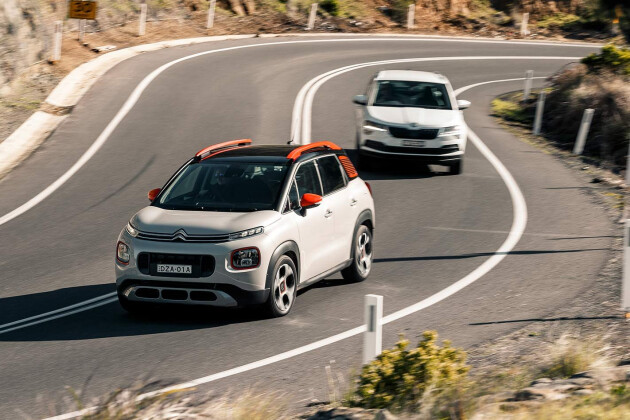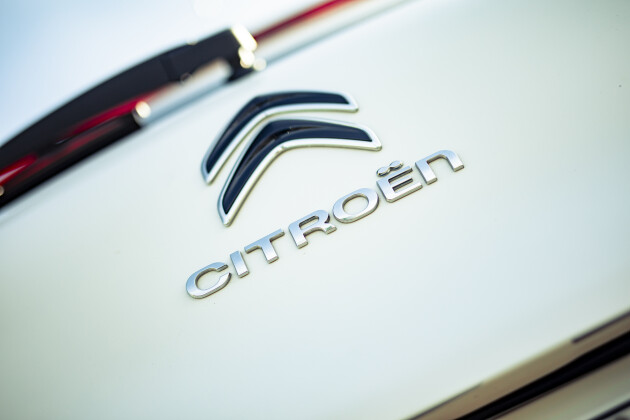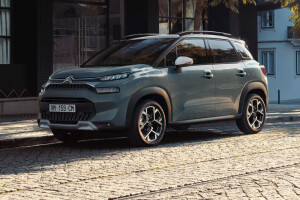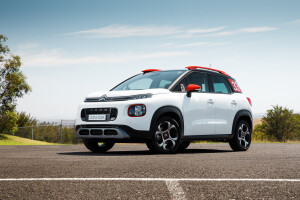Latest Review

Citroen’s C3 Aircross takes on the class-leading Skoda Karoq
Battling Citroen joins the booming baby SUV bunch, but is it Czech mate for the new C3 Aircross?
WHAT DOES Citroen have to do to catch a break in Australia? Famous as an early pioneer of front-drive, monocoque construction, aerodynamics, and hydropneumatics for superior suspension, steering and braking, the brand has been present here for most of its 100-year history – and in this magazine since August 1953 (only our third issue). Additionally, assembled in Melbourne for a time, the DS’s beauty has proven transcendental and tough alike, inspiring the Concorde while conquering rallies – including 1968’s gruelling London to Sydney marathon (until it crashed near the finish line). Yet Aussies choose to ignore such illustrious and inclusive heritage and instead treat Citroens with uncertainty and even suspicion. Just last year, it managed only 494 sales, against Mercedes’ 40,000 and 217,000 Toyotas.
Maybe the box-fresh C3 Aircross will break through. Based on the pretty C3 supermini, it is distinctive but not divisive, thrusting the Spanish-built bijou crossover into a happening segment for the first time … that is, if you ignore the Mitsubishi ASX-derived C4 Aircross of 2012 (which almost everybody did).
Priced from a steep $32,990, the Aircross resides between the $20-something-K mainstream ASXs and $45K-plus premium Volvo XC40s of this world, but it comes loaded with gear like AEB, blindspot monitoring (BSM), lane-departure warning (LDW), Apple CarPlay/Android Auto, aerial-view camera, auto on/off lights and wipers, climate control, DAB+ digital radio, keyless entry/start, a head-up display (HUD), sat-nav, self-parking and a Qi wireless phone charger. Fancy paint with some flamboyant detailing – as per our example – is the only option.
Here’s another, and at $700 less to boot: Skoda’s Karoq 110TSI with dual-clutch transmission (DSG), from $32,290. Visually less peculiar than the likeable, ironically Citroen-esque Yeti it usurps, the smartly coiffured Czech adopts the Golf 8’s MQB architecture, though ditches the rear multi-link of its predecessor for a torsion beam (matching the Aircross).
Where the standard Karoq cannot match its French foe is in a menagerie of acronym-addled gadgets (namely BSM, LDW, GPS, QI, HUD, DAB+ and auto parking), though the base instead boasts adaptive cruise and auto high beam. Note ours heaves with $9K’s worth of loot, equalling the Citroen’s haul (bar HUD) while adding LED lights, (vinyl-ish) leather, heated front seats (powered for the driver), a larger 9.2-inch touchscreen, upgraded audio, digital instrumentation, 18-inch alloys and more. Grand total? $41,590. For fairness, we’re overlooking most of these extras.
Still, there’s no ignoring the Skoda’s more expansive cabin. An outstretched hand span longer and a matchbox wider, size-wise the visibly lower Karoq resides in a real sweet spot, being roomy enough for smaller families yet compact enough for tight-spot scenarios. Dimensionally, think 2000’s Subaru Forester.
Furthermore, the Karoq’s dash presentation would do Volkswagen’s posher marques proud, defined by a textured, layered simplicity that’s invitingly functional. Along with room for five, key highlights include a fine driving position, effective ventilation, supportive seating, bountiful storage and abundant vision. This Skoda serves to please.
We also brought along an actual basic Karoq for a reality check … and guess what? While not as opulent as our bling box, the fabric trim feels softer and warmer, the standard analogue dials are crisper, and, even in touchscreens, eight inches is still larger than average. We’d forgo most of the options.
Plus, no SUV offers the immense versatility of the trick VarioFlex rear seat trio that individually slide and recline as required. They’re easy to remove too, unlike the fixed (for Oz only, to comply with our vexing design rules) Citroen’s. Sure, each is heavy to lift, but all that exertion results in a nifty two-seater van configuration. Enter Sandman, 2020-style.
In contrast, the Aircross’s cabin is noticeably narrower and somewhat toylike, though there’s plenty to drink in and enjoy.
Yes, the Citroen is slightly more hemmed-in inside, though canny cab-forward packaging, that lofty ceiling and deep glass conspire to provide a sense of light and space, in a way that the similarly mini Mazda CX-3 cannot. Minimalist in layout, the fascia is cohesive, the touchscreen improves with familiarisation, the seats feel instantly sumptuous and the satellite-pod instrumentation is chic.
But there’s no overlooking acres of hard, shiny plastics, a near-useless glovebox, paltry single cupholder, scattered switchgear (try finding the ‘Sport’ button quickly) and vision-hindering windscreen pillars. And while the rear comfortably seats two, the back lacks flair, face-level vents, a centre armrest, cupholders and adequate storage. The boot, too, is miles smaller. Advantage, Karoq.
That said, the Citroen claws back ground in two areas important to many compact SUV-buying urbanites: low-speed driveability and ride comfort. The former first. Under the Aircross’s snub bonnet is a thrummy and throaty 1.2-litre three-pot turbo triple, driving the front wheels via a Toyota-supplied six-speed torque-converter auto – a pairing that’s proved remarkably robust in many PSA models.
Though 81kW and 205Nm are ho-hum outputs, a trifling 1203kg – some 200kg shy of the Skoda – boosts the power-to-weight ratio, for snappy off-the-line acceleration and punchy mid-range throttle response. Perfect for darting through traffic or clean starts on steep hills. Vocal but never intrusive, the Citroen’s a lusty little livewire.
The opposite applies to the Karoq, which shines out on the open road. Armed with a 110kW/250Nm 1.5-litre four-cylinder turbo and seven-speed DSG combo, the 110TSI front-driver majors in providing a broader bandwidth of performance with maximum efficiency, minimum fuss and welcome refinement. The upshot can be less-than-smooth progress in heavy traffic or when crawling over inclines, as the DSG can feel laggy and even jerky. Frustrating for drivers desiring instant oomph.
Inevitably this means the Skoda trails the terrier-like Citroen up to 50km/h, but the 110TSI’s deeper lungs reel it in beyond that, by 1.4 seconds at 100km/h and a yawning 4.9s past 140. And though the Aircross pulls briskly between 80 and 120, it cannot catch the strident Karoq. Size matters here. Additionally, the Skoda proved only 0.3L/100km thirstier overall. Impressive.
Still, the Citroen keeps up in bends, thanks to quick steering and a planted, predictable chassis that soaks up the bumps with far more aplomb than a lightly laden Karoq. But, again, as speeds rise, the situation reverses, with the Aircross’s handling feeling a tad nervous blasting over zig-zag roads, often requiring two bites at the helm to maintain a chosen line. There’s also more body movement and less rebound control.
The 110TSI, meanwhile, glides on through such stuff with reassuring fluid finesse, its steering weighting up agreeably for a more controlled connection between car and driver. The Golf DNA is obvious here. Additionally – and even on bigger 18s – a loaded Karoq settles down and soaks up rougher surfaces almost as well as the plush Citroen, minus the lean.
Ultimately, the Karoq is a more refined and grown-up experience, eschewing the Yeti’s quirky nature for formidable all-round competence that’s as polished as it is practical.
The slick powertrain and firm suspension are much more harmonious away from the rigours of cut-and-thrust commuting, but then that’s where the charming C3 Aircross soars, lacking for little and giving much more than its diminutive numbers suggest.
So, while the Skoda is palpably more complete, the French car nails the city SUV brief with characteristic, charismatic chutzpah. We cannot imagine consumers finally flocking to dealerships, but it deserves to be that elusive thing after a century here – successful Citroen in Australia.
News
-
 News
NewsCitroën yet to hit triple-figure sales in 2021
Year-to-date performance almost a third lower than 2020
-
.jpg) News
NewsCitroen removes C3 Aircross from Australian line-up
Poor sales and a changing model range have left the Aircross out to dry
-
 News
NewsNew Citroen C3 Aircross: squidgy crossover facelifted
Citroen sharpens its baby crossover, adds spongey seats and more tech



